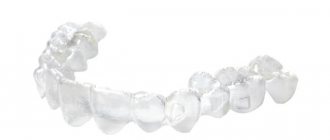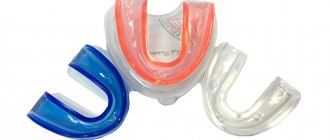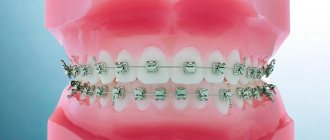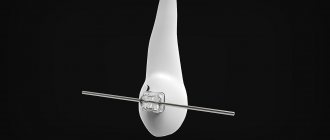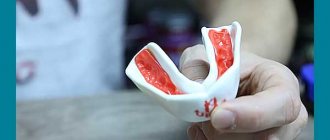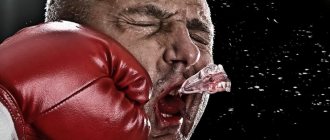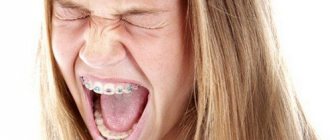Sports mouth guards
A sports lifestyle is becoming more and more popular, and at the same time the number of maxillofacial injuries received during sports is increasing. First of all, the front teeth of the upper jaw are injured; malocclusion in an athlete increases the risk of damage to the dentition.
The most traumatic sports for teeth are hockey, American football, rugby, skating, boxing, kickboxing, but damage to the dentition can occur during any sports activities where contact with a hard surface or other athletes is possible. Professional athletes are required to wear mouthguards; it is recommended that amateur athletes also use this simple but effective means of protection.
Purpose of sports mouthguards, types
What does a mouthguard give an athlete:
- Eliminates the possibility of teeth biting soft tissues at the moment of impact;
- Absorbs and distributes impact energy, thereby reducing the risk of damage to teeth, jaw bones and cervical vertebrae;
- Prevents occlusal contact and injury to opposing teeth during impact;
- Reduces the risk of concussion and the development of neurological disorders;
- Gives the athlete a feeling of confidence in his safety, so during competitions he focuses only on the game;
- Specially made mouthguards increase the strength, endurance and reaction speed of athletes.
Mouth guards can be one-sided (put on one jaw) or two-sided. Also, protective devices are divided into the following groups:
- Standard – sold in sports stores ready-made in several sizes. The disadvantage of such mouthguards is poor fixation on the teeth, lack of individual adjustment to the dentition, low degree of protection;
- Thermoplastic – also sold ready-made, but differ from standard mouthguards in the ability to be adjusted. The material of manufacture is thermoplastic; to adapt to the dentition, the mouth guard is preheated in hot water. They are more comfortable to wear compared to standard ones, but also a little more expensive;
- Individual - made for each athlete according to personal models based on dental casts. It is possible to manufacture mouthguards for teeth with braces, which is important for young athletes, since it is during adolescence that braces are most often installed.
Why do you need a sports mouth guard?
The goal of sports dentistry is to prevent injuries in sports. According to statistics, a high percentage of injuries in various sports are observed in the maxillofacial area: damage to the soft tissues of the oral cavity, teeth, lips, etc. Many of these injuries can be prevented or their consequences reduced if a person uses special protective equipment.
Some athletes require orthodontic treatment with braces. In this case, dental onlays, created according to the individual parameters of a teenager or an adult, take into account the movement of teeth and protect the braces system, as well as the patient himself, from possible damage.
On a note!
Additionally, sports mouthguards, for example, boxing mouth guards for braces, help prevent plates from peeling off from the surface of the teeth and protect soft tissues from injury by individual elements of the system.
An alternative option is the innovative Invisalign system.
Is it possible to do martial arts with braces?
In this case, Invisalign aligners may be a more suitable option. A mouth guard can be offered to athletes with less pronounced bite defects. It is made from a transparent elastic composite using a scanned image of the jaws and bite using IT technologies. The one-piece cast design allows for quick and effective tooth alignment and is an ideal choice for athletic patients.
Types of mouth guards
There are several types of sports mouthguards.
Single-sided mouth guards
The single-sided or single-jaw pad is comfortable and loved by many athletes. It absorbs up to 40% of the impact force, does not block the flow of air into the lungs and is inexpensive.
Double-sided mouth guards
A double-sided product, made simultaneously for two jaws, protects better than a one-sided one, but makes breathing difficult. It has a small hole for air flow, as a result of which athletes experience a lack of oxygen during a long fight, which affects the intensity of blows, coordination of movements and the general well-being of a person.
Molded mouth guards
The cost of a cast mouth guard is its only advantage. This product is universal and does not fit the shape of the jaw line and protects teeth and gums to a lesser extent. The product can prevent damage to teeth and lips, but does not reduce the force of impact.
On a note!
Another disadvantage of a cast mouthguard is the unpleasant odor.
Thermoplastic mouth guards
An affordable plastic cover that often breaks and does not guarantee the required protection. The product is softened in boiling water, after which the athlete places it on the teeth. In the front part, the material of the mouthguard quickly thins out, providing the least protection to the areas of the oral cavity where maximum protection is required.
Custom mouth guards
Leaders among protective caps. They have a high cost, but compared to previous models they have undeniable advantages:
- ideal anatomical fit to the surface of teeth and braces;
- effective protection;
- no problems with speech and breathing;
- reducing the risk of serious injury;
- decreased intracranial pressure, which increases when struck;
- the ability to drink water and drinks while wearing a mouth guard;
- individualization of the product by putting the athlete’s name or initials on it;
- hypoallergenic and safe material.
Important!
Experts say that athletes who use custom mouthguards are 3 times less likely to experience injuries to the teeth, jaws, and concussions compared to other similar protective equipment.
What is better – mouthguards or braces?
Unlike braces, aligners can be placed on teeth only to correct minor defects. Their design does not allow for significant bite correction, as when using a braces system. However, aligners have a number of advantages over braces:
- It’s easier to maintain hygiene – the mouthguard can be removed if necessary;
- there is no discomfort or chafing from the presence of solid elements in the mouth;
- diction is not impaired;
- visits to the orthodontist are required less often - the patient can independently change one mouthguard to another;
- The mouthguards are almost invisible in photos and in everyday life.
But you need to know about small disadvantages if you decide to install mouthguards:
- higher cost of treatment;
- the need to remove while eating, especially when eating hot food. The material is sensitive to high temperature;
- limited application possibilities - mouthguards are not used for abnormalities in the position of the jaws and serious malocclusions in adults.
In childhood, the possibilities for using mouth guards are wider. With their help, it is still possible to correct the bite, since the child’s teeth and jaws are better amenable to mechanical influence. Soft silicone mouth guards are more often used for children, while hard ones are used when treating adults. Trainers can also be made for children - special devices that can stimulate or slow down jaw growth and expand the dentition.
Sizes and taste qualities of caps
When wearing braces, sports mouthguards should be made from patient impressions from hypoallergenic material using multilayer technology (alternating different layers of hardness).
- Single-layer - product thickness up to 4 mm, recommended for children and non-professional athletes.
- Double-layer ones include two protective layers of 3 mm each. A lightweight option for those involved in professional sports and children.
- Three-layer systems between layers of 2 and 4 mm have an additional reinforced layer of 0.8 mm, protecting the most vulnerable areas of the teeth and soft tissues of the oral cavity. Recommended for use by professional athletes.
Important!
Lack of taste and odor is one of the main requirements for high-quality mouth guards. These criteria must be met at 0%, since when worn they can irritate a person's perception and cause allergies.
Stages of aligner installation
- preparation: oral sanitation, professional cleaning;
- 3D diagnostics (radiography, photographing the dentition and smile line, taking high-precision impressions (casts) of the upper and lower dentition, determining the closure of the dentition;
- 3D preparation of a treatment plan and coordination of: timing, complexity (one or two jaws), additional elements and structures at all stages of treatment;
- ordering all aligners or parts, in case of complex treatment;
- installation of aligners: using dental material to create attachments (protrusions) on the surface of the enamel of some (2-6) teeth for maximum pressure on the most rotated teeth, teaching the patient how to insert and remove the aligner.
You need to go to the doctor for a check less often than with a brace system, on average once every 2-3 months, it all depends on the stages of a pre-compiled 3D treatment plan. At the end of treatment, the doctor and the patient evaluate and compare the results obtained. If necessary, free re-diagnosis and correction are performed, with the production of additional aligners. The final stage is the removal of attachments, in some cases the manufacture of orthopedic structures, the fixation of a retainer - a small wire on the lingual surface of the teeth, the taking of impressions (molds) and the manufacture of a removable mouthguard or eline retainer to secure the result.
To eliminate bite defects, you will need more than one mouthguard. Replacing intermediate devices is necessary every 2 weeks, and the total treatment period can range from several months to 1-2 years. With each new tray, the teeth move a little and acquire a more correct position. A set of aligners is given to the patient, and he can independently change them after the prescribed period, coming to the doctor only for a preventive examination. This is convenient for busy people who often go on business trips.
Aligners must be worn at least 22 hours a day. The mouthguard can be removed when eating and brushing your teeth. You need to make sure that plaque and food particles do not accumulate under it, otherwise caries can easily form.
If mouthguards are used as a retention device after treatment with braces, it is enough to wear them at night. In this case, they are made in a single copy, separately for each jaw. Don't neglect wearing a mouthguard. If you haven't used it for several days or weeks, you may have difficulty putting it on. Teeth tend to return to their original position, especially the first time after braces are removed.
How to choose the right and popular brands
Features of mouth guards from different manufacturers.
- Everlast is the market leader in thermoplastic linings that provide superior oral protection. The brand's products are recommended for both beginners and experienced athletes. Mouthguards are made of plastic, EVA and EverGel technology. Country of origin: China.
- Venum - this brand's onlays are made of Nextfit Gel Frame material, have a low rise and fit the teeth perfectly. The flexibility and comfort of the two-layer system is successfully combined with the absorption of impact forces. Country of origin: Taiwan.
- Opro Gold Level UFC - the manufacturer's mouthguards are suitable for people who wear braces and dental plates. The pads are made of three-layer polymer material, are easy to install in the mouth, and are tasteless and odorless. Country of origin: Great Britain.
- Paffen-Sport presents single-layer mouth guards on the market, recommended for children and adults involved in non-professional sports. They are made of plastic and have a mint flavor. Country of origin: Pakistan.
- Flamma - mouth guards from this manufacturer have a double-sided shape, that is, they protect both jaws at the same time. They are made of high-strength rubber using two-layer technology. Country of origin: China.
Why do you need to order a mouth guard for sports?
Main functions of protective sports mouth guards:
- the plate protects the teeth from possible injuries - with it the risk of tooth damage is reduced by almost half;
- when using mouth guards, the risk of deformation of the temporomandibular joint is reduced, which, if damaged, is usually extremely difficult (and time-consuming) to restore;
- a sports pad is needed to facilitate the performance of athletes during sparring and tournaments - thanks to the special design of the mouth guards, they withstand the tension of the chewing muscles, which has a positive effect on the overall muscle tone and concentration at a crucial moment. Thus, the power of the blow increases, and in general, concentration on movements improves;
- When using mouthguards, protection is provided against abrasion of tooth enamel, which often happens when the jaws are tightly closed during sports.
How to properly use and care for a mouthguard
Using and caring for a mouthguard is not difficult, the main recommendations are:
- Do not expose the product to high temperatures (with the exception of thermoplastic devices). Scalding for the purpose of disinfection and drying in contact with hot surfaces are prohibited. Also, do not consume hot drinks or food while wearing the product.
- It is important to clean your mouthguard morning and evening with toothpaste and a brush intended for daily oral hygiene. If you ignore cleaning, an unpleasant odor and taste will appear as a result of the proliferation of microbes.
- It is recommended to store the pads in cases designed for this purpose.
General presentation and purpose
The starting point for the use of such structures is the last decade of the century before last, but mass distribution began only towards the middle of the twentieth century. Formally, the inventor of mouthguards in the form in which we know them today is considered to be the American dentist Rodney Liliquist - he was the first to describe in detail the technology for making a protective lining from acrylic.
A sports mouthguard for boxing is a product made of elastic material, worn over the upper dentition, the main function of which is to prevent injuries. Rubber, silicone, acrylic or vinyl acetate polymers are used as the basis for creation. The design separates soft tissues and teeth, absorbing impact energy during physical contact.
Alignment tray manufacturing process
The decision on the advisability of wearing mouth guards to straighten the bite is always made by the doctor, after examining the patient and performing a number of diagnostic measures. The specialist will determine the complexity of the defect, take into account the structural features of the patient’s jaws, and if no contraindications to the use of mouthguards are identified, an impression will be taken from the patient’s teeth.
The taken impression is sent to the laboratory, where it is used to model the future design. Based on the model, sets of mouth guards will be produced, which the patient will change during treatment. When the mouth guards are ready, the patient comes to the clinic again, where the design is tried on and the specialist gives detailed advice on how to properly wear and care for the mouth guards.
Choice and features of care
A competent approach to choosing protection is based on several factors:
- Level of load and risk – for light training and sparring at the entry level, the simplest rubber is quite suitable;
- Purchasing budget - if possibilities allow, it is best to order an individual model, which is likely to prevent damage of moderate and severe severity;
- Age of the athlete - a children's mouthguard for boxing should not only protect the child from the consequences of impacts, but also take into account the development of bone tissue, excluding forced deformation of the bite.
Caring for the product is not particularly difficult. Rinse after each use, regularly treat with an antiseptic and store in an airtight case - and it will serve you for 1-1.5 years from the date of purchase.
Applications on teeth using trays
These mouth guards are used to restore and strengthen tooth enamel. A special composition is placed inside the mouthguard, thanks to which the teeth are remineralized.
There are two types of mouth guards for dental applications – standard and thermoplastic.
Thermoplastic ones react to heat and soften when placed in hot water, and harden when put on the teeth.
